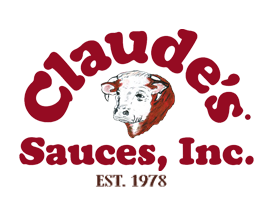
- 1 bottle of Claude’s BBQ Brisket Marinade
- One 5 1/2-pound first-cut brisket
- Kosher salt and freshly ground pepper
- 3 1/2 tablespoons vegetable oil
- 2 medium onions, halved and thinly sliced
- 4 garlic cloves, minced
- 4 carrots, cut crosswise 1 inch thick
- 2 medium parsnips, halved lengthwise and cut crosswise 1 inch thick
- 2 celery ribs, cut into 1 inch pieces
- 1/2 cup prepared white horseradish, drained
- 2 cups dry red wine
- 2 bay leaves, preferably fresh
- 3 cups beef stock or low-sodium broth
- 4 medium Yukon Gold potatoes, peeled and cut into 1 1/2-inch pieces
Take brisket and add Claude’s BBQ Brisket Marinade. Let sit for 4 hours. Preheat the oven to 325°. Season the brisket generously with salt and pepper. In a very large enameled cast-iron casserole, heat 3 tablespoons of the vegetable oil. Add the brisket and cook over moderately high heat, turning, until browned all over, about 12 minutes. Using tongs, carefully transfer the brisket to a rimmed baking sheet, fat side up.Take brisket and add Claude’s BBQ Brisket Marinade. Let sit for 4 hours.
Preheat the oven to 325°. Season the brisket generously with salt and pepper. In a very large enameled cast-iron casserole, heat 3 tablespoons of the vegetable oil. Add the brisket and cook over moderately high heat, turning, until browned all over, about 12 minutes. Using tongs, carefully transfer the brisket to a rimmed baking sheet, fat side up.
Pour off all but 3 tablespoons of the fat from the casserole. Add the onions and half of the garlic and cook over moderate heat until softened, about 3 minutes. Add the carrots, parsnips and celery and cook over moderate heat until browned in spots, about 6 minutes.
Meanwhile, in a small bowl, combine 1/4 cup of the prepared horseradish with the remaining garlic and 1/2 tablespoon of vegetable oil. Spread the garlic-horseradish paste on the fat side of the brisket.
Pour the red wine into the casserole. Bring to a boil and cook over high heat, scraping up the browned bits from the bottom of the casserole, 1 minute. Push the vegetables to the side of the casserole and add the bay leaves. Set the brisket, horseradish side up, in the center of the casserole. Pour the beef stock around the brisket and bring to a simmer over moderate heat. Cover the casserole, transfer to the oven and cook for 1 hour.
Scatter the potatoes around the brisket, cover and cook for about 2 hours longer, until the meat is very tender. Increase the oven temperature to 350°. Uncover the casserole and roast for about 30 minutes, until the brisket is browned on top and the gravy has thickened.
Carefully transfer the brisket to a carving board and let rest for 30 minutes. Discard the bay leaves. Using a slotted spoon, transfer the vegetables to a serving platter and cover with foil to keep warm.
Pour the brisket cooking liquid into a fat separator and let stand until the fat rises to the surface. Pour the cooking liquid into a gravy boat and discard the fat. Whisk the remaining 1/4 cup of prepared horseradish into the gravy and season with salt and pepper.
Thinly slice the brisket across the grain and transfer to the platter with the vegetables. Spoon some of the gravy over the brisket and vegetables and serve, passing the remaining gravy at the table.
Pour off all but 3 tablespoons of the fat from the casserole. Add the onions and half of the garlic and cook over moderate heat until softened, about 3 minutes. Add the carrots, parsnips and celery and cook over moderate heat until browned in spots, about 6 minutes.
Meanwhile, in a small bowl, combine 1/4 cup of the prepared horseradish with the remaining garlic and 1/2 tablespoon of vegetable oil. Spread the garlic-horseradish paste on the fat side of the brisket.
Pour the red wine into the casserole. Bring to a boil and cook over high heat, scraping up the browned bits from the bottom of the casserole, 1 minute. Push the vegetables to the side of the casserole and add the bay leaves. Set the brisket, horseradish side up, in the center of the casserole. Pour the beef stock around the brisket and bring to a simmer over moderate heat. Cover the casserole, transfer to the oven and cook for 1 hour.
Scatter the potatoes around the brisket, cover and cook for about 2 hours longer, until the meat is very tender. Increase the oven temperature to 350°. Uncover the casserole and roast for about 30 minutes, until the brisket is browned on top and the gravy has thickened.
Carefully transfer the brisket to a carving board and let rest for 30 minutes. Discard the bay leaves. Using a slotted spoon, transfer the vegetables to a serving platter and cover with foil to keep warm.
Pour the brisket cooking liquid into a fat separator and let stand until the fat rises to the surface. Pour the cooking liquid into a gravy boat and discard the fat. Whisk the remaining 1/4 cup of prepared horseradish into the gravy and season with salt and pepper.
Thinly slice the brisket across the grain and transfer to the platter with the vegetables. Spoon some of the gravy over the brisket and vegetables and serve, passing the remaining gravy at the table.



